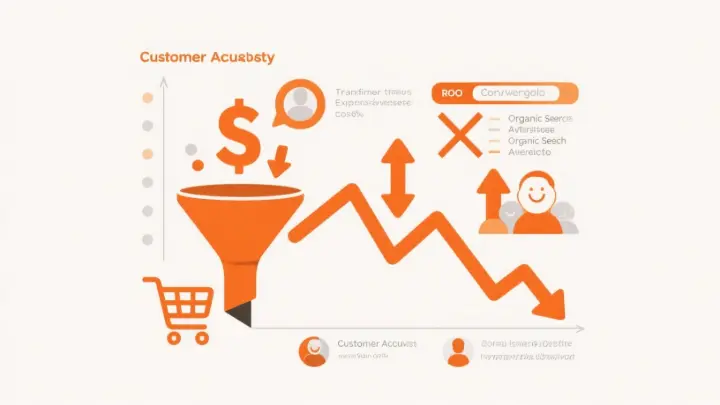Remember the last time you typed something into Google and it somehow knew exactly what you meant, even though your search was kind of vague? That's semantic search working its magic. And honestly, if you're running a business in 2025 and not leveraging this technology, you're leaving serious money on the table.
I've watched countless businesses struggle with skyrocketing customer acquisition costs while their competitors seem to effortlessly attract the right customers. The difference? They understand that semantic search isn't just about rankings anymore. It's about connecting with people who are actually looking for what you offer.
What Makes Semantic Search Different from Traditional Keyword Matching
Let me break this down in plain English. Traditional search was pretty dumb, if I'm being honest. You typed "best running shoes for flat feet" and the search engine would literally look for those exact words. Miss one word, misspell something, or phrase it differently, and boom, you'd get irrelevant results.
Semantic search changed everything by understanding the context of your search and your intent for searching to deliver the most relevant results. Think of it like the difference between talking to a robot and having a conversation with someone who actually gets what you mean.
When someone searches for "affordable wireless earbuds with good battery," semantic search understands they're looking for budget-friendly Bluetooth headphones that last long, even if those exact words don't appear on your product page. Modern semantic search systems process queries through multiple layers of AI-powered services that convert text into mathematical representations called embeddings, capturing semantic meaning and contextual relationships between concepts.
The Real Cost of Ignoring Semantic Search in Your Business Strategy
Here's where things get interesting for your bottom line. A 2024 survey showed that businesses leveraging semantic search in their internal knowledge bases saw a 34% reduction in time spent by employees searching for information. That's not just a productivity boost, that's money saved every single day.

But the cost savings don't stop there. SEO reduces customer acquisition costs by as much as 75% compared to paid media because it allows you to capture customers before they know about your brand by targeting top-of-funnel keywords that would be too expensive for PPC. When you're spending hundreds or thousands of dollars on paid ads, cutting that cost by even half makes a massive difference in your profitability.
Think about your current marketing budget. How much are you burning on ads that bring the wrong people to your site? People who click, bounce, and never come back? That's exactly what semantic search optimization fixes.
How Semantic Search Technology Actually Works (Without the Tech Jargon)
You don't need a computer science degree to understand this. Semantic search uses natural language processing and machine learning to figure out what people really want. NLP works to understand the meaning of the search terms, while ML helps detect patterns in data specific to a particular user.
Picture this scenario. Someone types "yellow tablet" into a search engine. Old-school keyword search would show paper notebooks, iPads, and yellow pills all mixed together. Semantic search looks at the person's browsing history, location, and other context clues to show them what they actually meant, whether that's a tech gadget or medication.
Semantic vectors enhance keyword search by providing better synonym recognition, improved understanding of context, stronger conceptual understanding, and enhanced recognition of misspellings and variants. This means your content gets found even when people don't use your exact terminology.
Reducing Customer Acquisition Costs Through Smart Content Strategy
Let's get tactical. Sites using semantic analysis SEO strategies saw 2x more featured snippet placements and significantly better visibility in SGE results. Featured snippets are gold because they put you at position zero, above even the first organic result.
Instead of stuffing your content with awkward keywords that make you sound like a robot, semantic SEO lets you write naturally while still ranking well. You create comprehensive, helpful content that answers real questions people have. Pages that match search intent see up to 52% lower bounce rates. Lower bounce rates mean Google trusts your content more, which means better rankings, which means lower acquisition costs.
The beauty of this approach is that it compounds over time. Unlike paid ads that disappear the moment you stop paying, organic search acts like a flywheel that keeps producing traffic, whereas paid traffic immediately vanishes the moment you stop buying ads.

Slashing Operating Expenses with Internal Semantic Search Systems
Your customer-facing search isn't the only place where semantic technology saves money. Businesses leveraging advanced search technologies in their internal knowledge bases saw a 30-35% increase in productivity. When your employees can find what they need instantly instead of wasting 20 minutes digging through folders or asking colleagues, that time adds up fast.
Imagine a customer support team that can instantly pull up the right solution instead of putting customers on hold while they search. Companies use semantic search to enhance their customer support systems and chatbots, understanding customer queries more accurately and delivering precise answers quickly. Faster resolution times mean happier customers and a support team that can handle more tickets without hiring additional staff.
For ecommerce businesses especially, semantic search on your site means customers find products faster. Semantic search understands user intent, not just keywords, helping customers find exactly what they want, even with vague or conversational queries. When shoppers find what they want quickly, they buy more and return less.
Voice Search and the Future of Customer Discovery
Have you noticed how many people now talk to their devices instead of typing? Over 50% of all online searches will be conducted via voice by 2025. Voice searches are conversational and long-form. Nobody says "best pizza Chicago," they say "where can I find the best deep-dish pizza near me that's open right now?"
Semantic search handles these natural language queries beautifully. If your content is optimized for semantic search, you're automatically positioned well for voice search too. No extra work required.
Implementing Semantic SEO Without Breaking the Bank
You're probably wondering what this costs to implement. The good news is that semantic SEO doesn't require expensive tools or massive budget increases. It requires smarter content strategy.
Start by understanding what your customers actually want. Content optimized for E-E-A-T (Experience, Expertise, Authoritativeness, Trustworthiness) earns 28% more visibility in search results over time. Write comprehensive content that demonstrates real expertise. Answer questions thoroughly instead of giving surface-level responses.

Use long-tail keywords naturally in your content. 92% of search queries are now long-tail (4 words and more), indicating users are searching for specific information. These longer, specific phrases often have less competition and higher conversion rates because they capture people with clear intent.
Add structured data markup to your pages. It sounds technical but it's basically giving search engines a clear map of what your content covers. This helps you show up in rich results and answer boxes, which drive more qualified traffic.
Measuring ROI and Tracking Your Success
Here's what matters. You need to track organic traffic growth, conversion rates from organic search, time saved in internal search systems, and ultimately, your customer acquisition cost trending downward.
Studies show that increasing customer retention rates by just 5% can boost profits by 25% to 95%. Semantic search helps both acquisition and retention because it connects people with the right information at the right time.
Monitor your keyword rankings, but pay more attention to whether you're ranking for the right keywords, ones that bring people who actually convert. By providing quicker, more accurate searches, your customers have an easier time finding what they're looking for, which can result in greater customer satisfaction and higher sales.
The Bottom Line on Semantic Search and Your Business Growth
Look, the reality is simple. Search engines are getting smarter every day. They're moving away from simple keyword matching toward truly understanding what people want. Businesses that adapt to this shift will dominate their markets. Those that don't will keep burning money on ineffective marketing.
Semantic search optimization isn't about gaming the system or finding shortcuts. It's about genuinely understanding what your customers need and creating content that serves them well. When you do that, everything else follows. Lower acquisition costs, better customer experiences, higher conversion rates, and ultimately, a more profitable, sustainable business.
The question isn't whether you should optimize for semantic search. The question is whether you can afford not to.